Consensual Hallucination drove that SPAC boom during the free-money era.
By Wolf Richter for WOLF STREET.
EV maker Fisker, which had gone public via merger with a SPAC in October 2020 amid fake promises and ludicrous projections, and then burned over $1 billion of investor cash, has finally filed for bankruptcy protection Monday night, following in the footsteps of a bunch of other EV SPACs.
These EV SPACs were born during the era of free money and what we’ve come to call consensual hallucination, and reality just didn’t matter. They raised billions of dollars in cash from free-money-befuddled investors, went public at sky-high valuations, then their shares collapsed and were inducted into our pantheon of Imploded Stocks. Then they began filing for bankruptcy, one after the other.
All these EV SPACs, those that have already filed for bankruptcy and those that will still file for bankruptcy, have the same problem:
It takes a huge amount of money, engineering expertise, and management expertise to start up an automaker, design vehicles, build a factory, develop the supply chain, and ramp up mass-production of high-quality desirable vehicles, and then sell them in such large numbers – hundreds of thousands of vehicles a year – and at a high enough a price that the company can become cash-flow positive and survive on its own without further cash injections.
It took Tesla over 10 years and about $20 billion to get there, and it has been profitable ever since. The Model Y is now the #2 bestseller in the US, behind the Ford F-150 pickup. So Tesla made it, and it became the most valuable automaker in the world, even though its shares plunged to where in December 2022, Tesla made it into our pantheon of Imploded Stocks (entry requirement: at least -70% from high).
Frisker, run by CEO Henrik Fisker, has been a mess from Day One. And even before Day One: He’d already driven its predecessor company, Fisker Automotive – which made the plug-in hybrid Fisker Karma – into bankruptcy in 2013. Nevertheless, investors were eager to douse him with more money, including over $1 billion when the company went public via merger with a SPAC in October 2020. When money is free, nothing really matters.
Fisker never made it to true mass-production. It didn’t even build its own vehicles – they’re made under contract in Austria by Magna Steyr, a subsidiary of Canada-based Magna International. The batteries came from the Chinese battery giant, CATL. Fisker started selling its Ocean SUV last summer. In 2023, Magna built 10,000 of them. But amid reports of all kinds of quality problems, Fisker was able to sell less than half of them in 2023, and promised to sell the rest in Q1 2024.
At the end of February, Fisker warned in a filing that it might not be able to “continue as a going concern.” And it said that it was in talks with a major automaker over an investment in the company and a joint production deal.
On March 18, Fisker said it paused production of the Ocean for six weeks. At the end of March, Fisker slashed the price of the SUVs by as much as 39%, hoping to sell the ones it still had, though it was no longer producing new ones. But it’s hard to talk people into buying a vehicle when the company is about to collapse.
And on March 25, Fisker said that those talks with the major automaker went nowhere. The New York Stock Exchange then delisted Fisker’s shares, due to their nearly worthless nature – just a few cents at the time. The delisting put Fisker in default on its $180 million in convertible notes. Throughout, Fisker has been laying off employees and closing facilities.
On May 3, Magna International said in its earnings call that “production of the vehicle is currently idled,” and its outlook “assumes no further production.” On May 7, Fisker’s Austrian subsidiary, Fisker GmbH, filed for bankruptcy in Austria. On May 19, Fisker closed its headquarters in California. And so that was the end – sealed by the bankruptcy filing.
Shares of Fisker closed at 2 cents today, from 4 cents yesterday, on the news of the bankruptcy filing. They’ve been in that range for months.
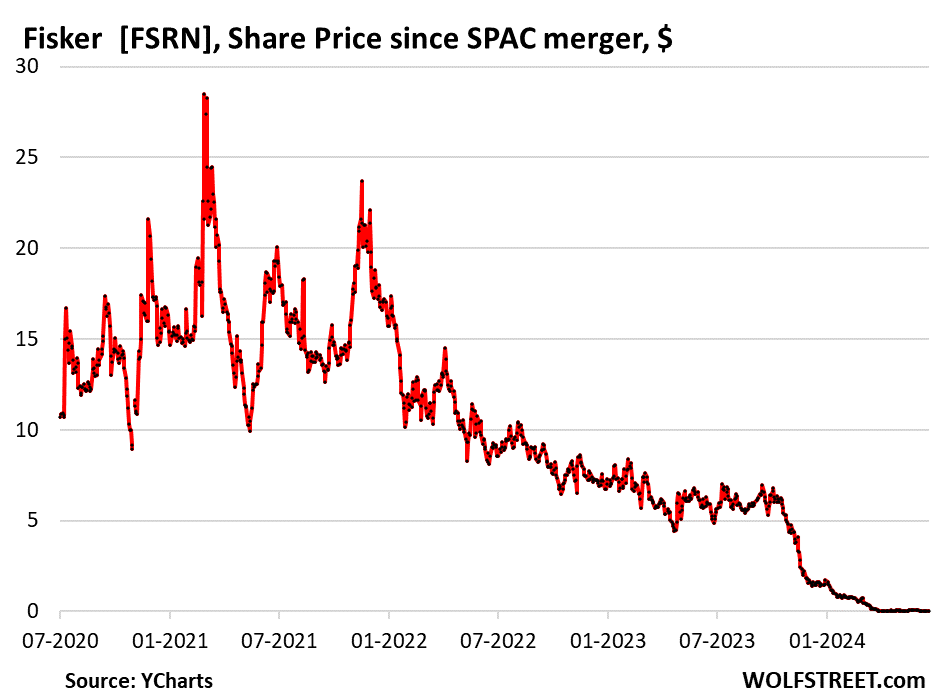
EV SPACS that are no longer twitching:
Electric Last Mile Solutions took only 12 months from SPAC merger to bankruptcy filing in June 2022.
Proterra, which made mostly a few electric buses, filed for bankruptcy in April 2023, about 25 months after having gone public via merger with a SPAC. It once had a market cap of nearly $4 billion.
Lordstown Motors, which tried to make electric pickups, made the trip from SPAC merger to bankruptcy in June 2023 in a little over 2.5 years, during which it lied to investors to get more of their cash and stay alive.
EV SPACs that are still twitching…
VinFast Auto [VFS], a Vietnamese EV maker that’s part of the conglomerate VinGroup, went public in the US via merger with a SPAC on August 15, 2023, with a minuscule float. Its shares then exploded while we discussed, on August 25, 2023, this misbegotten creature. By October 10, the stock had plunged 92%, becoming one of our all-time favorites in the pantheon of Imploded Stocks. Shares have continued to tank. Today they closed at $3.92, down 96% from the high. Its market cap has imploded from over $230 billion to a still ridiculous $9 billion.
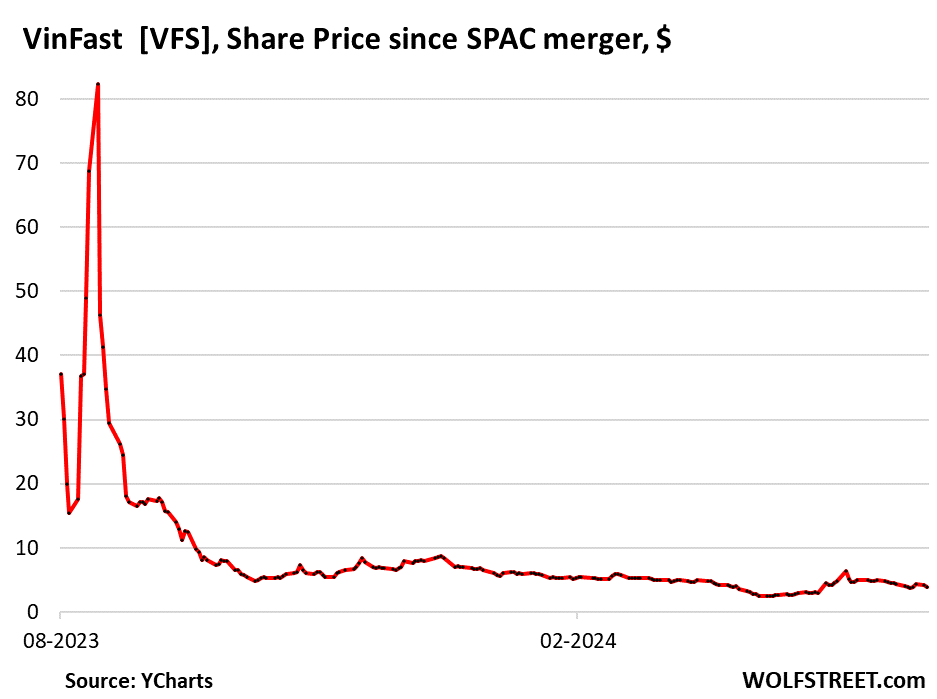
Nikola [NKLA], at $0.48 today, has collapsed amid scandals and lies by 99% from its high in June 2020 when the merger with a SPAC was approved. Last December, CEO and founder Trevor Milton was sentenced to four years in the hoosegow for lying investors about the company’s technology.
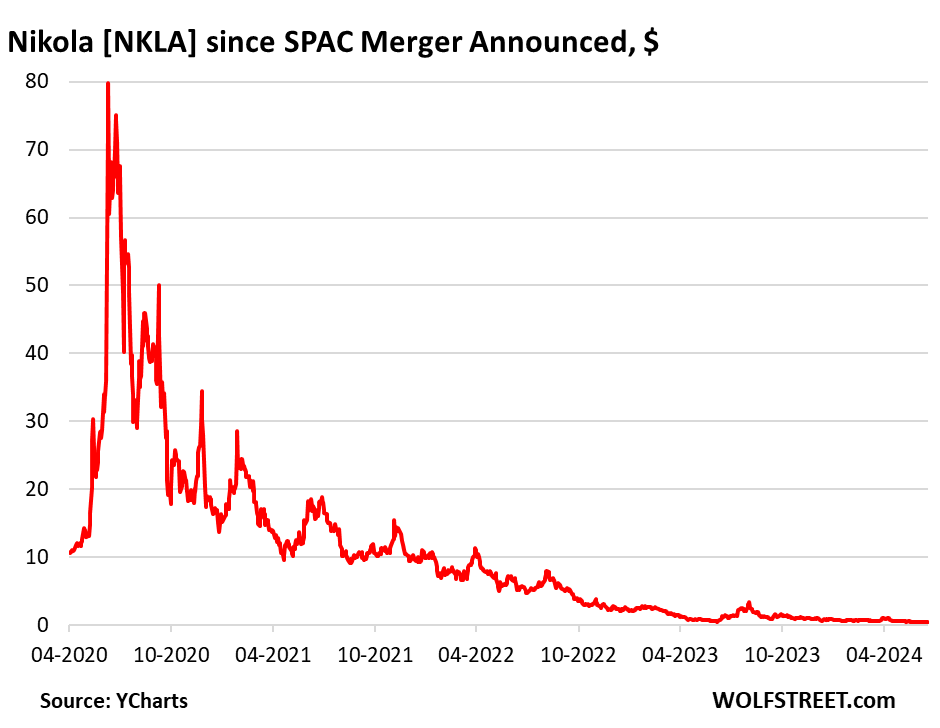
Canoo [GOEV], SPAC merger completed in December 2020. In March 2024, it imposed a 1-for-23 reverse stock split, where each 23 shares became just one share to keep the price above $1 to keep it from getting delisted. Today, shares closed at $1.82, down 99% from the peak. Cherry on top: It recently bought some of the assets of bankrupt EV maker Arrival in the UK.
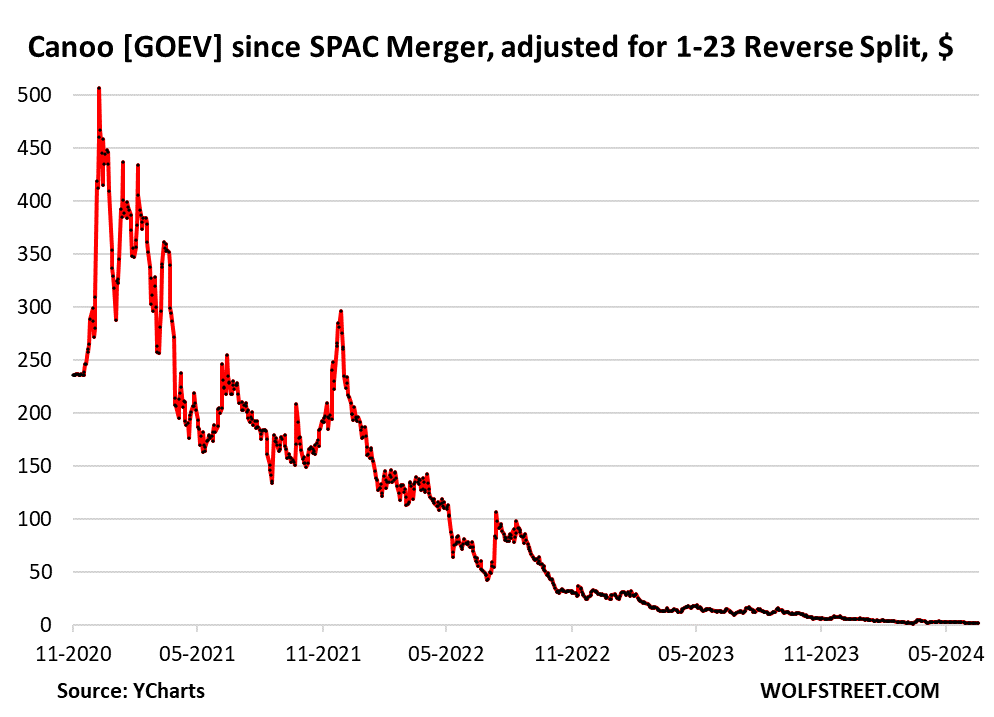
Lucid Motors [LCID], SPAC merger announced in February 2021. The company raised another $1 billion from an affiliate of Saudi Arabia’s Public Investment Fund (PIF), which had already invested $5.4 billion in the company and owns 60% of it. Now $2.57. From peak: -96%.
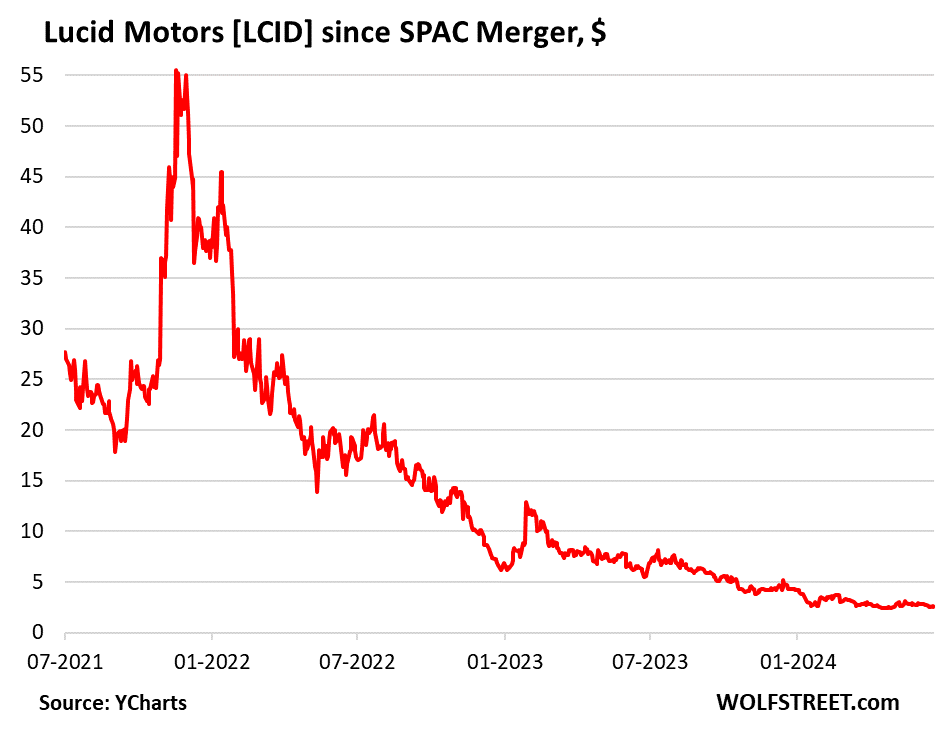
Faraday Future [FFIE] SPAC merger completed in July 22, 2021. It imposed two reverse stock splits: In August 2023, a 1-for-80 reverse split, where each 80 shares became one share; and in February 2024, a 1-for-3 reverse split. After both splits, 240 shares became 1 share. On May 29, 2024, it withdrew its 2024 production forecast and warned that it might file for bankruptcy. Shares closed at $0.47 today, having plunged by 99.99% from the peak. These kinds of scams are just funny.
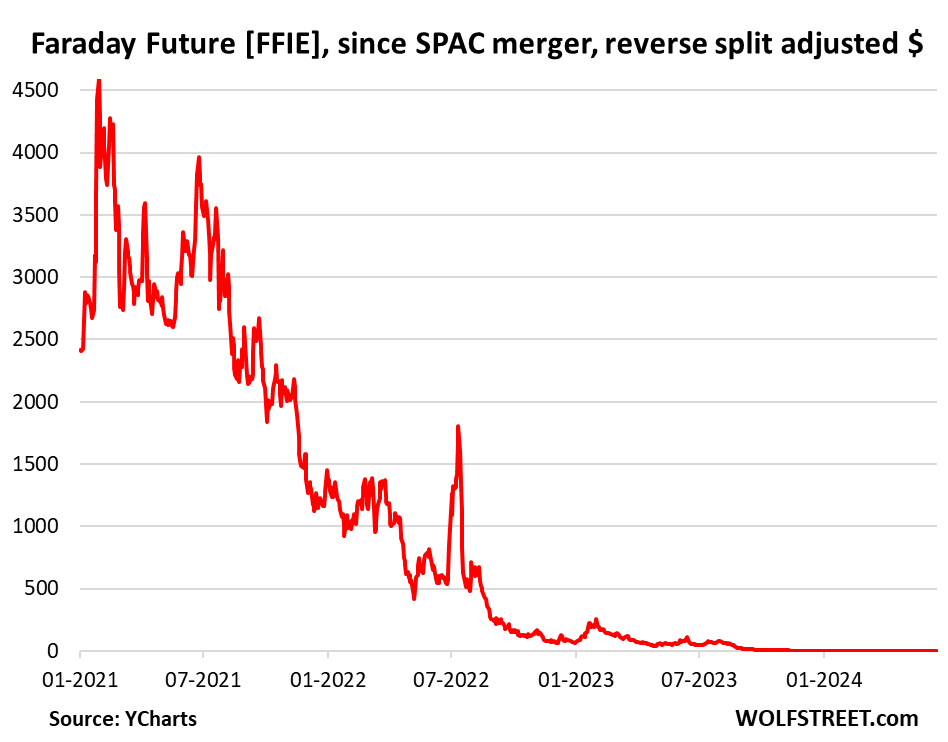
Lion Electric [LEV], a Canadian company that makes electric trucks and buses, SPAC merger November 2020, now $1.04, from peak: -96%
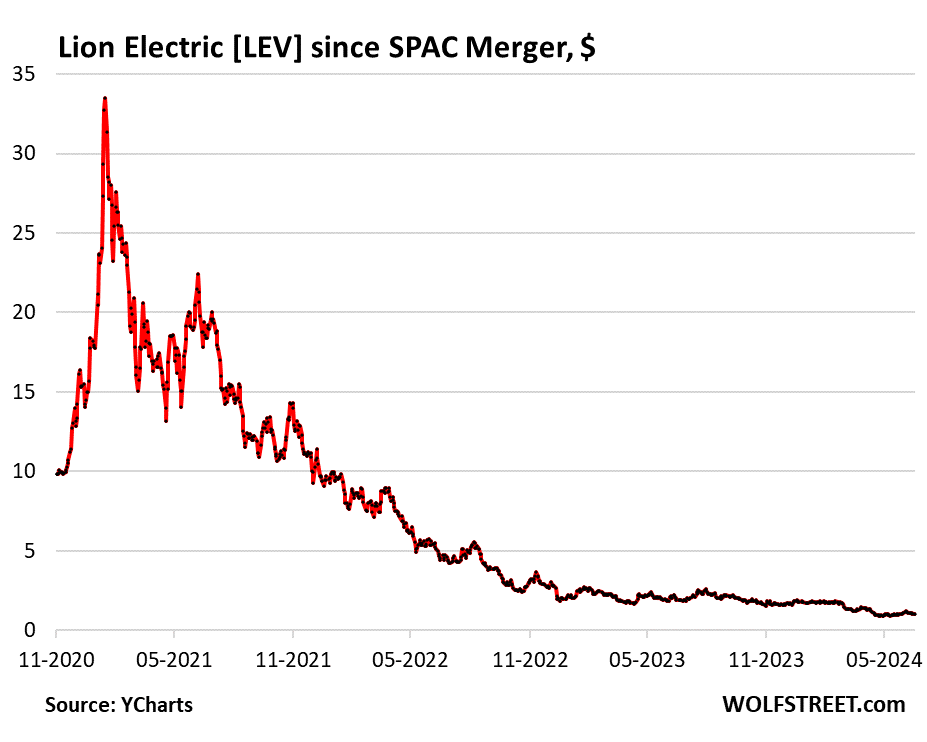
Polestar [PSNY] SPAC merger completed in November 2022; started trading in June 2022 at $11, giving it a market cap of $23 billion. The stock is now at $0.69, down 96% from the peak. The company is majority owned and controlled by Chinese giant Geely, which had bought Volvo, which had bought a startup that became Polestar. The vehicles were made in China. This year, its factory in South Carolina has started production.
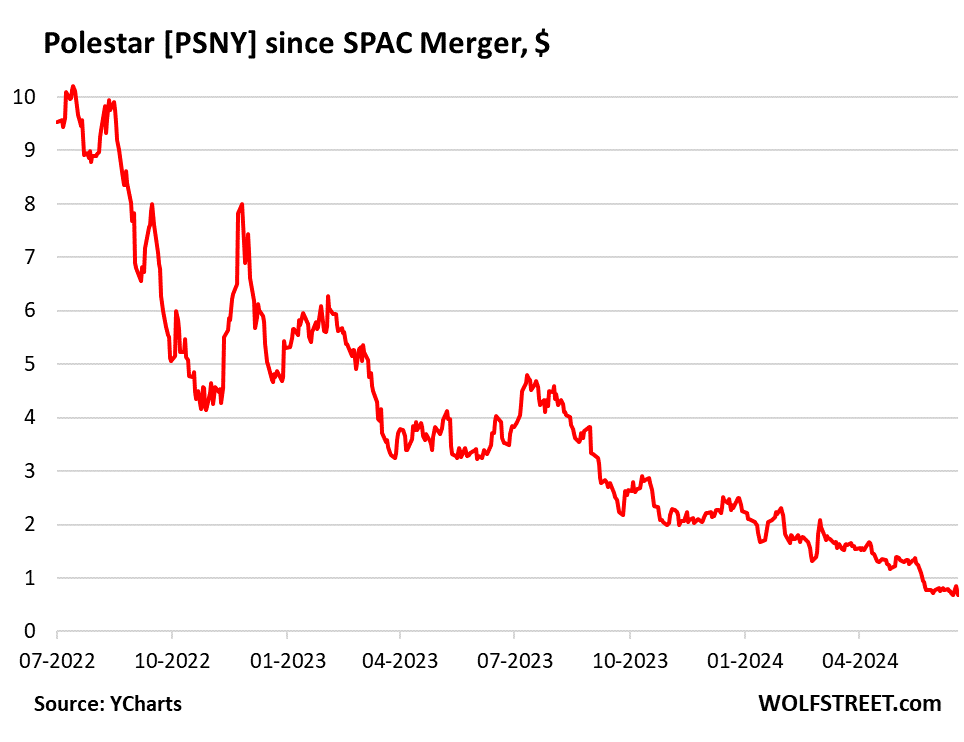
Rivian is not part of this list because it went public via classic IPO in November 2021. It’s ramping up mass-production, has burned through billions of dollars, but has good vehicles that are now driving around in larger numbers – a big SUV, a big pickup, and commercial vans. It has Amazon as one of its backers and huge customer for its commercial vans. It’s now a question of how much more cash investors are willing to heap upon it to burn. Tesla needed $20 billion to make it. Rivian’s runway may be shorter. It has long been in our pantheon of Imploded Stocks. Its shares closed at $11.02 today, down 94% from the peak in November 2021.
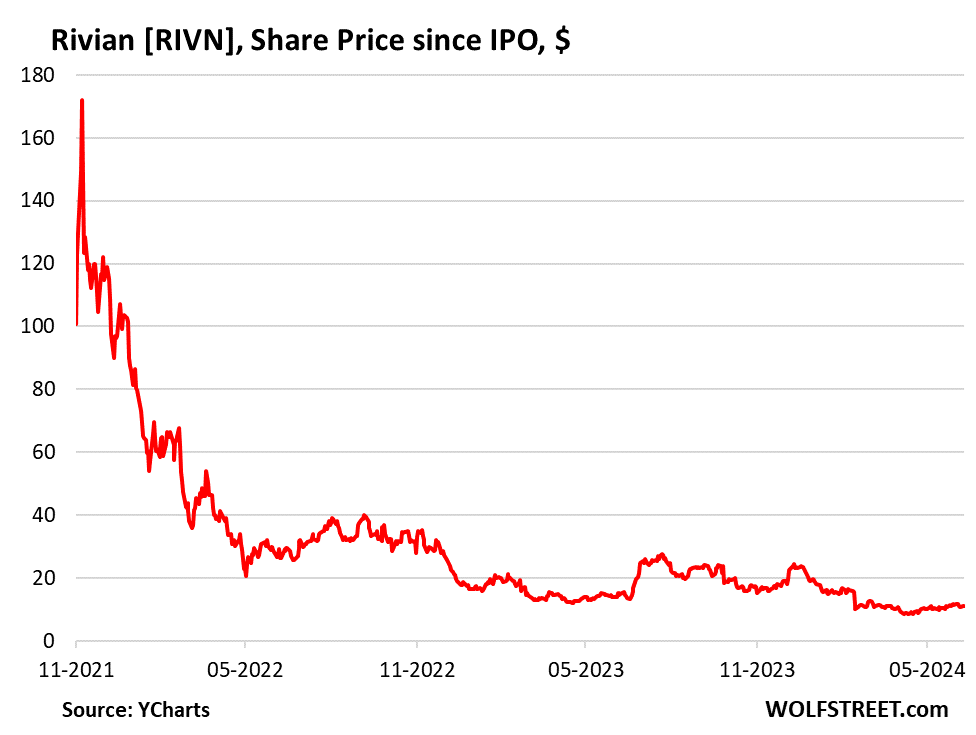
Enjoy reading WOLF STREET and want to support it? You can donate. I appreciate it immensely. Click on the mug to find out how:
![]()


Can’t be that hard to slap a lithium battery to 4 motors and call it a car. With all that dumb money and still can’t make it work, maybe old Fisky needs to leave cars to others. Anyway, how many more zombies are out there? Thought these “high” interest rates were going to ring out excess, guess it takes a little longer when less than neutral rate.
“Thought these “high” interest rates were going to wring out excess, guess it takes a little longer when less than neutral rate.”
It’s going to take a lot longer. All of the mania has shifted to Nvidia.
Because the FED refused to finish the job. They needed to raise another 150 basis points. Instead, they paused, then started jawboning rate cuts. Look at the S&P since last fall.
How long before you’re writing about the collapse of the AI mania, on the verge of bankruptcy? Six months? These EV companies only lasted a few years on billions of dollars.
The euphoria in the air does seem familiar. This article brought back its whiff very vividly.
Given the insane number of *all* SPACs (not just EV focused ones) in 2020-21 (maybe 600-700?), it would be interesting to get an update on their aggregate fates.
(I think SPACs had to invest with 2 years, so the vast majority should be invested or dissolved by now, I think).
Never really understood Wall Street’s motivation for SPAC frenzy during pandemic (why not simply underwrite same old trashy IPO’s/mergers?).
I suppose it had something to do with the pandemic and gobs of money coming due/in to Wall Street’s high net worth customers – bur why not sell them the same old trash…what made SPACs special?
It was like some holding pen had to be created in a rush during the pandemic…but I’m not particularly sure why.
(Also unclear where huge surge of available HNW money was coming from…it wasn’t like HNW investors could get hundreds of billions in uncommitted pandemic money…they may have gotten hundreds of billions but it had to be passed on to their idled workforces during the pandemic or repaid to the G).
Any data/thoughts?
SPACs come with much less information about the business, compared to normal IPOs. So via SPACs it was possible to sell bad companies. This only works well during a mania. Also they are faster to the market than IPOs.
In general: avoid reverse mergers.
SPACs are the perfect vehicle to fleece retail for cash
…never underestimate the marketing power of: “…as heard on radio…”, “…as seen on TV…”, or “…my friend saw on the internet…”…
may we all find a better day.
…But Wait!….
Things will get really interesting in the EV space when chinese exports come to market. BYD was once a Warren Buffett investment. I don’t know if it still is. Baidu supposedly sells a robo taxi.
Should really shake things up.
“can’t be that hard” … and yet this article has a dozen examples of companies that tried and failed to sell EVs for a profit.
Are they all missing something that is obvious to you? If it is so easy, I am sure Lucid would be happy to give you a slice of that $1b investment to fix their tiny problem of selling at a 40% discount to their gross margin
what about Trumps Media SPAC ?
I’ll just address this question from two angles:
1. During the peak SPAC boom from 2019 through 2023, a total of 1,037 SPACs went public via IPO and raised funds for an acquisition of a target company. Most of them, but not all, then merged with an existing company, such as the EV makers or with what became Trump Media. So I don’t cover them all. I do cover the auto industry, so what’s why the EV SPACs fit here.
2. DJT is different in my view from the other SPACs, in that I think people considered it a form of campaign contribution – because it could potentially make Trump a lot of money which could potentially help him win the election – or a form of political support for Trump, rather than a classic speculative investment. I don’t know what to make of it. It’s kind of a weird creature, as far as publicly traded companies are concerned.
You may be right that most “investors” consider DJT to be a campaign contribution, but one could also consider it to be a speculative gamble with, according to the polls, about 50/50 odds with double?, triple? quadruple? or nothing.
If Trump loses then it is worthless (unless one frames the stock certificate) but if he wins…
Say Prince Bonesaws wants to buy influence. Before he had to pay for thousands of unused nights at Trump’s hotel, which with the overhead resulted in what, 5% getting into Trump’s pocket?
Then there was the 2 billion to Jared, but again that was not directly into Mr. Ts pocket, but now…
Put 2 billion into Truth Social advertising, say for advertising Saudi vacations, or anything else for an audience of one, and viola, 40% of the 2 bil goes directly into Mr. Ts pocket and 60% to the other shareholders, so yes there could be huugggge profits and dividends.
Now, how lucky do you feel today?
I know this is an article about imploded EV stocks, but after reading it I was wondering if Rivian and Polestar at these low imploded prices may be a good investment? My understanding is that both Rivian and Polestar make decent EVs. What will it take for these 2 companies to survive and become profitable?
They at least make quality vehicles. The real test is whether they can sell enough to outlast their cash burn. So far, the jury is still out.
Heh the same thought crossed my mind too. I’m also starting to see more and more Rivians and Polestars in my area.
Still don’t like either company’s bal sheet.
Jorgen,
I see quite a few Rivians around here, nice looking vehicles. I talked to a couple of owners, and they love their trucks. So they’re real, and people are buying them. But they’re expensive to produce, with all their advanced drivetrain features, etc. Rivian is now coming out with toned-down tech versions that are a little less costly to produce. The question is this: can Rivian ever get its per-unit costs down to where it can sell them profitably in large enough volume to become self-sustaining? That is a HUGE challenge. Rivian is far from it. But it’s the requirement for Rivian to survive. So I think as potential investor, you would want to come up with an answer and a timeframe to that question.
In terms of just me, Polestar is a no-go because it’s controlled by a Chinese company. The US stock market is littered with collapsed Chinese stocks, even as the companies in China seem to be doing OK.
Wolf,
Did you notice how the Rivian SUV gets its styling cues from the old International Scout. Even the logo looks similar from a distance and they seem to be partial to the Mustard Yellow color that was popular on Scouts back in the day.
I haven’t made that connection. But next time I see one, I’ll try.
Most of these companies had the one and only purpose of extracting money from investors. Obvious fraud or hidden fraud. I am short Tesla and Rivian.
There’s a photo of Einstein with, on the wall, portraits of the three physicists whom he thought his greatest predecessors – Newton, Faraday, and Clerk Maxwell.
So I regret that Faraday’s name has been taken in vain by car fakers.
Tesla used Tesla, and it seems to have worked out. Tesla is much more famous now than Tesla ever was.
The thing that Faraday is famous for is the “Faraday cage” (I even learned about it in high school) — a cage not being exactly what I would like to be alluding to as automaker.
Yes, Tesla is a HUGE name in Europe. I mean the scientist.
Faraday invented the electric motor.
But that’s boring compared to a guy sitting inside a metal cage suspended from the ceiling that gets hit by a powerful noisy artificial lightning bolt. And then he climbs out alive – now THAT’s impressive to a kid!
Wolf, without the electric motor, Tesla the car company wouldn’t exist.
But Elon could probably have created the electric motor in a weekend as he is SUCH a genius…
And Nikola Tesla invented the AC induction motor, without which we would be using the modern equivalent of whale oil lamps.
A cage of consensual hallucination if you were dumb enough to buy the stock?
Easier to break out of a Faraday cage than out of that investment…
Nothing beats the silence of whoever lost their shirts in the latest bust. Failure is an orphan.
‘The thing that Faraday is famous for is the “Faraday cage”’
Oh you are a wag.
Wouldn’t they need a faraday cage to drive those EV? I imagine of lot of radiation just sitting on those massive batteries while driving.
A car IS a Faraday cage. That’s why you survive unharmed inside a car when it gets hit by lightning. Any time there is a flow of electricity anywhere, there is an electromagnetic field (EMF) around it, including inside your home. Even ICE vehicles emit EMFs when you drive, and a big one when they’re started. But all levels of EMF in all vehicles are small and far below the value recommended by the International Commission on Non-Ionising Radiation Protection (ICNIRP).
BTW, misconception here, there is no electricity stored inside the “massive batteries”; electricity is created in the battery through a chemical reaction when needed. And it’s the flow of the newly created electricity to the motors and other electric devices and instruments that creates an EMF.
…a Faraday Cage-match among physicists names for EV firms? (…sorry, couldn’t resist…).
may we all find a better day.
Faraday cage also giving me too many hints of a mixed martial arts fighting ring.
Perhaps the fight promoter can use one to guarantee an electrifying show performance?
Michael Faraday also invented those handy items the electric motor and its mirror image the electric generator.
Faraday made the first public demonstration of the electric motor. The British PM at the time – Gladstone – was in the audience. At the Q and A session Gladstone asked what application to government the motor would provide? Faraday replied: “The government would be able to tax it”.
From the Googli machine:
Nikola Tesla made dozens of breakthroughs in the production, transmission and application of electric power1. His greatest achievements include:
Alternating current (AC)
First hydro-electric power plant at the base of Niagara Falls
X-rays
Induction motor
Measurement of flux density
Wireless transmission
Pioneer of wireless technology
Advancement of x-ray
First remote controlled-device
Applications of fluorescent bulbs and neon lamps
A towering giant for sure!
For clarification, Röntgen discovered the X-ray and its first applications in 1895;
“ Radiography’s origins and fluoroscopy’s origins can both be traced to 8 November 1895, when German physics professor Wilhelm Conrad Röntgen discovered the X-ray and noted that, while it could pass through human tissue, it could not pass through bone or metal.[24] Röntgen referred to the radiation as “X”, to indicate that it was an unknown type of radiation. He received the first Nobel Prize in Physics for his discovery.[25]
I’m still back at why is there a “+” and a “-” or a “N” and a “S”…..
….don’t learn well, I guess…..
These are interesting enterprises, having occurred since the start of stock markets. It was never real money being initially transferred from the Greedy and Gullible to the Greedy and Sharp, but how did the G&S then turn it into actual money that circulated through society? Builders of factories, suppliers of concrete and steel, mechanical and electrical design engineers, advertising and sales, all being individual people being paid with the original G&G’s funds. Money being circulated very efficiently into many hands, should one not just call it a form of business, without pinning ‘car’ onto it? It appears as if the G&G money has disappeared, but that was not necessarily the case. Wolf, how about an interview with Fisker to find out what he did with his share of it? To Ferrari assemblers in Italy, diamond miners in Botswana, Phillip Patique designers in Switzerland? Regrettably I am not a customer of any and without the Fisker type of wealth, ill-gotten or not, they would not exist.
Never explained, what is a SPAC ? No one has asked ?
Special Purpose Acquisition Company, also called “blank check company,” a shell company without operations that goes public via IPO at $10 a share and raises cash that way, committing to invest that cash (usually over the next two years) by acquiring an existing company with actual operations. This is a way for the acquired company to become publicly traded without going through the requirements of an IPO.
Before a SPAC announces a merger target, the shares trade at around $10. If no merger target is found after two years, or after some extensions, the SPAC is dissolved and the funds returned to investors.
An entertaining article that invites further inquiry via Google. I agree with comment that fraud facilitated by cheap money and hopium is part of the story. Electric Last Mile given the term’s use for the final steps before going to the electric chair is an ironic name for a startup venture. The company’s top two executives who are veterans of Ford and GM have been scrutinized for insider trading prior to the SPAC deal. Of interest is “Another SPAC scandal: Top ELMS leaders resign over discounted stock buys” https://www.freightwaves.com/news/another-spac-scandal-top-elms-leaders-resign-over-discounted-stock-buys
Also impressed by how much money from big investors like sovereign wealth funds, hedge funds, states, and big European banks these ventures attracted.
I have a few old stock certificates from the 1920’s . They are from newly minted automobile companies, all in North Carolina. One even has a letter from company officer thanking the person for investing. None of the companies made it.
Fisker will be back from ashes. Third time is the charm.
They make good gardening sheers.
Fiskars?
Henry Ford had two bankruptcies before he scored with his third.
I like hoosegow almost as much as slammer.
Rivian lost $38,784 per vehicle sold in the most recent quarter, and over $300,000 per employee, and they’re still around. How bad were Fisker’s losses?
Don’t worry, Rivian will make it up in volumn.
On the SF Peninsula (Where I’ll see “over” a hundred Teslas and at least a dozen Rivians and a few Lucids on a typica day) I hear the mood is shifting where people are worried that if they buy a Rivian or Lucid that they won’t be able to find anyone to fix the vehicles if the companies go under. P.S. I had a new Amazon electric delivery truck pull up next to me at the gas station last week (the driver went into the gas station mini-mart to get a snack) and I noticed that it had a Rivian badge on the side.
If Rivian’s losing almost $39,000 per vehicle sold, maybe we should warn the company we will buy one of their vehicles unless they give us a cheap free vehicle worth $20-25,000 from another manufacturer?
Upon receipt of requested car, we sign an agreement we will walk away forever without buying a Rivian, so the company saves at least $14K in the process.
Zero Sum – interesting discussion in Rivian’s boardroom: “…should we consider Zero’s proposal against our current strategy of buying scale & market share with investor funds???…”.
may we all find a better day.
There’s a company I was reading about a while back, it started out years ago as a Brazilian “media company” whatever that is, but “content creation” was hot back then, and then this company became a “cannabis consulting” company, whatever that is but Cannabis was hot back then, and now it’s in.. you probably guessed it, “AI”, it’s pretty hot right now 😆. They have a total of 0 employees from what I gather but they’re definitely buying like a billion dollars worth of Nvidia chips. If memory serves, they’re called “Hyperscale Nexus” and I bet you they’re going to be around for a while. All of these EV “makers” could learn something here.
Welcome to pink sheets. Nothing new. It began with Dot com bubble. There is no shortage of get rich quick dreamers/gamblers.
It just really hits home how much of this “free money”, as Wolf calls it, there really is out there, I’d think the SPAC and EV implosion alone would result in a Dotcom like collapse, but no there’s enough left over to roll right into the AI boom and Crypto stuff is back at fairly high valuations too. I wonder how much longer this goes on, forever?
As long as the global economy supports $2 trillion annual deficits, that’s my guess.
They printed dollars to manufacture a new floor under asset prices for the wealthy.
Is it a dream if they wake up suddenly filthy (stinking) rich?
The social phenomenon is what worries me. The effect of this perpetual casino-go-round feeds into a growing sense of unreality; that nothing much means anything — and that’s bad for the business of being.
All kinds of “Mal-being” are fairly well defined and they have a pill or a PAC or a religion for most all of them.
So, should I tell you not to worry about your business?………as I have a tough time with reality (or un) also.
“Welcome to pink sheets.”
I’ve always wondered how many companies that end up in the purgatory of pink sheets ever recover and become viable and profitable.
Anyone know?
In the absence of fiscal responsibility and accountability (bad things happening to those who make bad choices) bad money chases out good and capital/resources get mis-allocated. The amount of capital mis-allocation that has occurred globally is unprecedented. What happens next will also be unprecedented.
Hedge accordingly.
“The amount of capital mis-allocation that has occurred globally is unprecedented. ”
This is what I’m seeing everywhere.
Awhile back, I read a book titled “Amusing Ourselves to Death” and that’s what it looks like to me. The bread-to-circuses ratio is out of whack and we have way too many circuses and running short of bread. And forget about the “guns vs butter” discussion – non-starter.
Of course, none of it matters because it’s all just part of Wolf’s “consensual hallucination” world.
I’m with you – hedge accordingly.
Thoughts on Mullen?
Never heard of it–and I follow the auto industry somewhat closely–so I looked it up (noticed misspelling on homepage: ‘Dedline’ instead of ‘Decline’ on cookie policy button; not a good look to this pedantic homo sapiens). My wholly uninformed take: Will take trajectory similar to Lordstown’s, maybe Rivian’s. Tariffs notwithstanding, the Chinese will eat everybody’s lunch. Eventually.
I watch for typos like a hawk on the website I manage.
It’s like telling the whole internet “I don’t know how to proofread.”
“I don’t know how to proofread.”
Obviously, EV spac failures are tied to a beautiful trend:
“Of the 986 U.S. SPACs that have IPO’d since 2020, 362 have liquidated, according to the research shared exclusively with Inc.May 9, 2024”
I continue watching Latch, a spac that started its life with about $1.5 billion, which now hovers around 40 cents per illiquid share value. It’s apparently is rebranding but as it continues to bleed cash, it looks like a hopeless zombie.
I watch it, because my apartment complex has Latch Bluetooth doors, and a potential bankruptcy by them could potentially be very disruptive to thousands of tenets.
I think the entire spectrum of spacs will face similar cash burn dynamics.
Note that when a SPAC “liquidates,” it means that it did not find a merger target, and did not merge with another company, and shut down after it hit its two-year limit, and gave IPO investors their money back. In this case, the insiders that started the SPAC lose some money, not the IPO investors.
From Harvard Law School Forum on Corp. Governance:
Although SPACs issue shares for roughly $10 and value their shares at $10 when they merge, by the time of the merger the median SPAC holds cash of just $6.67 per share.
The dilution embedded in SPACs constitutes a cost roughly twice as high as the cost generally attributed to SPACs, even by SPAC skeptics.
When commentators say SPACs are a cheap way to go public, they are right, but only because SPAC investors are bearing the cost, which is an unsustainable situation.
Although some SPACs with high-quality sponsors do better than others, SPAC investors that hold shares at the time of a SPAC’s merger see post-merger share prices drop on average by a third or more.
The WSJ had a very recent article explaining that a growing number of regional banks are issuing instruments they call synthetic risk transfers to hedge funds. These are, in effect, credit default swaps that can provide (at a cost of about 7+%) insurance for a portion (about 12%) of their loan portfolio. So, if they have a portfolio of car loans that may go sour, they can get about 12% protection rather than get caught with their reserve’s pants down. This is to help prevent another SVB failure.
The financial unicorns keep proliferating.
That WSJ article comment is not part of the Harvard comment = a separate bitch if you will.
Wolf, this may be considered a dumb question, but I always have a sick feeling that these companies have somehow managed to obtain loans that are part of the MBS which roll up under the $9T in assets that the Federal Reserve has accumulated. So when they go bankrupt it is the average US citizen who now owns that debt since the Fed’s asset is now worthless.
Is any of this money coming from the Feds Balance Sheet? Or is it all from investors who took a big risk?
Oh dude, what a confused mess. I’ll try to sort it out for you, item by item:
Your #1 paragraph, part 1: If those companies got any loans, they’re held by banks or investors. These loans have zero to do with MBS (Mortgage-Backed Securities), and can never be part of MBS, and don’t end up on the Fed’s balance sheet.
Your #1 paragraph, part 2: The Fed used to have a $9T balance sheet; now, after two years of QT, down to $7.3T. How did you miss that?
Your #1 paragraph, part 3: When these companies go bankruptcy, investors, who hold their shares and their debt, stand to lose what’s left of their shirts. “Average US citizens” that didn’t invest in these companies and didn’t work for them have nothing to do with these companies and aren’t touched by them, or their blowups or their losses, and couldn’t care less.
Your #1 paragraph, part 4: “since the Fed’s asset is now worthless.” LOL, I’d sure like to have some of those “worthless” assets.
Your #2 paragraph, part 1: “Is any of this money coming from the Feds Balance Sheet?” Nope, nothing to do with the Fed’s balance sheet. Nada, zilch.
Your #2 paragraph, part 2: “Or is it all from investors who took a big risk?” Correct.
Wolf:
You said correctly “It takes a huge amount of money, engineering expertise, and management expertise to start up an automaker, design vehicles, build a factory, develop the supply chain, and ramp up mass-production of high-quality desirable vehicles, and then sell them in such large numbers – hundreds of thousands of vehicles a year – and at a high enough a price that the company can become cash-flow positive and survive on its own without further cash injections.”
And I would have added not just an auto company but any real hardware; also some tinge of luck. Being at the right place at the right time with the right qualifications.
That is why this country has moved on to Financial engineering and all sorts of knowledge engineering (massaging the bits and bytes like in GenAI, social media development), app development and so on. No real hardware (except the high end ones you say we still make like big automation systems, SC hardware that we are afraid to sell to others now, the great, duopoly Boeing aircrafts).
In spite of losing this kind of money, investors are chasing new one, like Dell, HP and now Apple (how often an average joe has to upgrade a PC or smartphone when (s)he is not able to use even the existing features (really qualified guys can make movies with present day smartphones!).
I thought the article linked below would give an idea to your readers where the GenAI might be going (not my paper; sharing to share the knowledge):
ChatGPT is Bu__S__t : https://drive.google.com/file/d/1UkI3Z5eunMNZGnAZq-LenjFZ03Wl7RJr/view
You get a $7500 government subside when you buy a Tesla. That seems a little un-free market. Where would they be without massive government handouts?
Agreed, these subsidies are stupid and unnecessary.
Tesla sales were booming for years WITHOUT the subsidy that started in 2023. The original $7,500 federal tax credit was phased out when automakers hit 200,000 deliveries in the US. Tesla sold its 200,000th unit in the US in 2018. And between 2018 and 2023, there was no federal subsidy for Teslas, and Tesla sales boomed, see chart below.
BTW, the subsidy program (actually a tax credit) is very complex. For example, you don’t get the subsidy when you buy certain Tesla Model 3s (only the long-range AWD and the performance model qualify). But you get it when you buy most Model Ys. Other EV makers also get the subsidies if their vehicles qualify; some qualify, some don’t. Leasing jumps over some of the restrictions. The whole program is idiotic.
US annual vehicle sales by automaker:
https://wolfstreet.com/2024/01/04/ugly-charts-of-auto-sales-by-gm-toyota-ford-stellantis-oh-my-got-crushed-by-hyundai-kias-record-sales-tesla-has-arrived/
The biggest ripoff was that our captive finance company was claiming the Fed subsidy as the *owner* of the EV (and before that hybrid) and not passing it on to the lessee. Nice way to pad their profits and pass the cost onto the manufacturer so they got their cake and ate it too.
It was a happy day for me when I blew that out of the water. First time I ever had a *visit* from the CEO of the captive for narc-ing to the CEO of the manufacturer on that swindle.
Wolf,
Where the hell is the SEC?
Bubbles are part of the inflationary cycle.
Is the Fed the only outfit tasked with trying to get this under control?
There are a lot of legitimate complaints about how Jerome Powell has handled this, but if he is basically alone in trying to rein in the nonsense, it does help explain why things are still bonkers.
Well, the founder and CEO of Nikola was sentenced to four years in the hoosegow.
True, but the SEC could have threatened a “stop trading” order on the stock.
If the promoters of this nonsense (and the bankers who finance them) are at a serious risk of losing their shirts, instead of being able to sell to bag holding speculators, my guess is this would start dying down fairly quickly.
As much as we complain about the Fed, the SEC has a lot of power over the public markets and could smash this nonsense if they really wanted to.
How do you think about this?
Tulip – it’s hard to think of the contemporary SEC without also thinking of the late 20th century saw of: “…the Establishment always subverts the dominant paradigm…”.
may we all find a better day.
Tesla will be the next company to join the imploded stock list. Take away the tax credit and add the $11,000 Chinese EVs from Mexico that bypass the recently negotiated trade agreements (US MCA) and its game over for EVs in the USA.
https://wolfstreet.com/2022/12/24/tesla-joins-my-imploded-stocks-70-from-peak-object-of-religious-veneration-turns-into-automaker/
Tesla went on a temporary leave of absence from the pantheon of Imploded Stocks during the massive 2023 rally. Now on the way back. I’m saving its old place in the pantheon. It needs to drop another $60 or so, and it can have its old place back.
Good.
I’m looking forward to seeing Tesla join Wolf’s list of imploded stocks. The sooner the better.
SC:
Might be sooner than you think. Automotive Snooze published an article alluding to a survey that reported some 40% of EV buyers wouldn’t replace their existing one with an EV….
El Katz,
You’re trafficking in cherry-picked anti-EV bullshit headlines. The same survey also found:
The number of respondents globally who say that they’re going to purchase a BEV (battery electric vehicle) for their next car grew to 17.6% this year, up from 14% in December of 2021.
Overall, 70% of respondents said they’d either be getting a BEV or PHEV next or, at the very least, only expected to own one more gas-powered car before switching over to an electric car.
https://www.theautopian.com/why-44-of-potential-electric-car-buyers-are-postponing-a-switch-to-evs-study/
Is there a post you talk about Tesla valuation and roadmap while facing tarrif protection and Chinese competition? What’s your metrics ?
I have to issue a correction to my post above. It won’t be game over for the EVs in the US. It will be game over for a large segment of the ICE US auto industry. The EVs do have a place in urban areas like where I live where you run a lot of short errands , and an $11,000 EV car makes a lot of sense, especially if you have a home charging station. Watch those cars start flooding the US market as soon as the Mexican factory is in full production. Those high paid union workers in Michican will be SOL (s$it out of luck).
NVIDIA’s 591,078% Rally to Most Valuable Stock…
Echoes of Dot-Com Boom…
Howdy Folks. So maybe we can stop the Govern ment subsidies for all companies that do not need it ? Didn t a EV builder just get a 56 Billion payday?
No, just the CEO! And he also is the CEO of a starship company! And his pay package was approved by the shareholders.
At least he’s not hawking real estate to people who can’t
afford it. LOL!
There are a lot of Teslas out there in my suburb of the Swamp. These are driven by people living in homes over 2 million in apprasial value. So some poor slob in the flyover country is working his ass off and paying full taxes on his income, probably working a second and third job to put food on the table and gas in his car so that these upper middle class snobs can get a tax subsidy to keep them living in their elevated lifestyle at someone else’s expense. All in the name of “Saving the planet”. Something doesn’t compute, here.
The poor slob is taking his girlfriend and the dog camping in the old 97 dolphin this weekend, life is good.
When he gets back from camping he starts his new job making a few dollars more, Life is good.
The creature from the swamp wishes him the best.
the electric vehicle tax credit is not eligible for couples making 300,000 dollars a year. so it’s likely that these people aren’t getting a subsidy.
A couple who owns an appreciated $2M house doesn’t necessarily make $300K. $2M houses are a dime a dozen in certain markets. The dump I owned in when we were living in Seal Beach, CA we bought for $600K…. it’s now *worth* in excess of $2M.
$56 Billion Paperday, not payday. It would bump him to 20% owner of Tesla. Also, Tesla does not pay dividends.
Is there a online list available with all those SPACs listed on any US stockmarket ?
I don’t know of a list. I have my own list of Imploded Stocks, which include hundreds of post-SPACs.
Both Lucid and Polestar have storefronts in one of Silicon Valley’s last remaining shopping malls: Westfield Valley Fair. Tesla storefront across the street in Santana Row.
NKLA and TSLA should do a merger – now there’s a name you can confidently invest in!
TSuNKLA
I went by my “Gas Station from Hell” yesterday. Still posting $4.89/gallon for regular. Everything is going up in price around here. I predict the price at my favorite gas station will top $5 gallon before July 1st.
4.89/gallon
Yikes that a hefty tax tacked on that gallon.
Testament to how insane our financial world and the general retail investors has gotten to, in which we continue to give people that fail upward over and over again more money…yup easy money is the cause of all the brain rot we experienced over the last decade or so. Another good example is Adam Neuman and how he is getting more money again to start another future fail venture…
“Frisker, run by CEO Henrik Fisker, has been a mess from Day One. And even before Day One: He’d already driven its predecessor company, Fisker Automotive – which made the plug-in hybrid Fisker Karma – into bankruptcy in 2013”